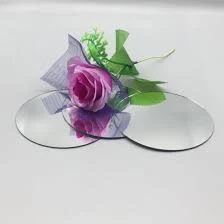

The Allure of Mirror Glass Design Reflection and Innovation
In the world of interior design, the use of mirror glass has become a captivating trend that transcends mere aesthetics. It blends functionality with creativity, offering a unique approach to creating spaces that are not only visually appealing but also multifunctional. Mirror glass design plays with light, dimensions, and reflections, bringing a contemporary edge to various settings, from residential homes to commercial spaces.
Understanding Mirror Glass Design
Mirror glass design refers to the innovative use of reflective glass surfaces in various applications, from furniture to wall decor. The concept is based on the fundamental properties of glass, which can reflect light and images in intricate ways. This reflective ability can transform a mundane space into an expansive area filled with light and character. The choice of mirror glass comes in different varieties, including polished mirror, antiqued mirror, and colored mirror glass, each providing a distinct aesthetic quality.
Creating Illusions of Space
One of the most significant advantages of mirror glass design is its ability to create illusions of space. For smaller rooms, such as apartments or studio-style living spaces, strategically placed mirror glass can visually expand the area, making it appear larger and more open. Floor-to-ceiling mirror walls can amplify natural light and enhance brightness, lending an airy feel to a confined space. This ability to manipulate perceptions of space makes mirror glass a favorite among designers who specialize in maximizing small areas.
A Play on Light and Color
Mirror glass is not just about reflection; it also plays with light. Different treatments can alter how light interacts with the surface, affecting the ambiance of the room. For example, a clear polished mirror can amplify daylight, while antique mirror glass, with its muted, textured appearance, can create a warmer, more intimate atmosphere. Designers often use colored mirror glass to inject personality into spaces, allowing for creative applications in bathrooms, kitchens, and living rooms. These colorful reflections and translucent layers enhance depth and vibrancy, contributing to a room's overall mood.
Functional Elegance

Beyond aesthetics, mirror glass has a functional aspect that is often overlooked. In furniture design, pieces like mirrored coffee tables, side tables, or cabinets not only add elegance but also serve practical purposes. They can contribute to a sense of luxury and sophistication in home décor while being easy to clean and maintain. In commercial environments, mirror glass can be employed for branding purposes, displaying logos and messages effectively while enhancing the spatial experience for customers.
Challenges in Design
Despite its many advantages, integrating mirror glass into design comes with its own set of challenges. One primary concern is maintenance. Mirror surfaces can easily show fingerprints, dust, and smudges, requiring regular cleaning to maintain their pristine appearance. Additionally, the placement of mirror glass must be carefully considered to avoid creating chaotic or disorienting reflections that can distract from the overall design narrative.
Sustainability in Mirror Glass Design
As sustainability becomes an increasingly vital aspect of design, manufacturers are exploring eco-friendly options for producing mirror glass. Innovations in sustainable practices aim to reduce waste and energy consumption during production. Designers are now more likely to source mirror glass that meets eco-friendly standards, ensuring that beauty does not come at the expense of the planet.
Conclusion
Mirror glass design offers a unique blend of beauty, functionality, and innovation. Its ability to reflect, refract, and enhance spaces makes it an indispensable tool for modern designers. Whether used to create illusions of spaciousness, play with light, or function as elegant furniture, mirror glass continues to inspire creativity in the design world.
As trends evolve and new technologies emerge, the applications of mirror glass are likely to expand even further. This versatile material will undoubtedly remain at the forefront of the design landscape, captivating us with its capacity to transform our environments into reflective canvases of light and space. In an age where aesthetics and functionality coexist, mirror glass design exemplifies the ideal harmony of both, providing a timeless appeal that resonates across generations.